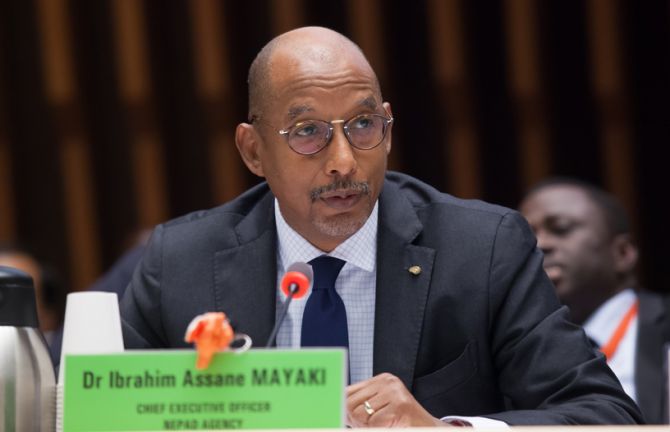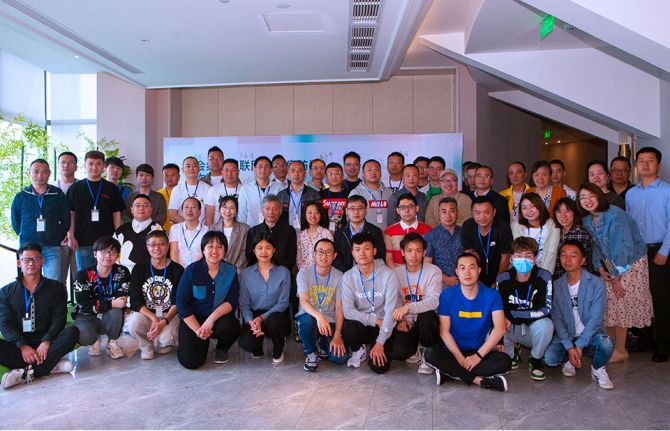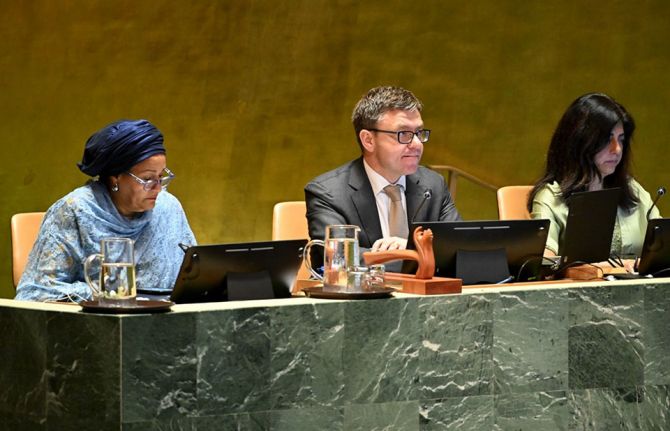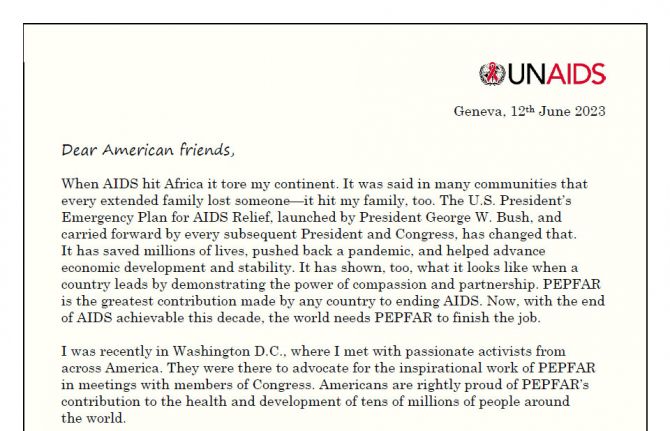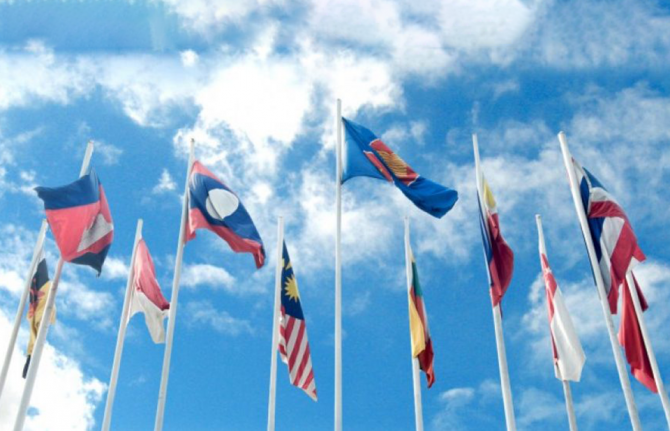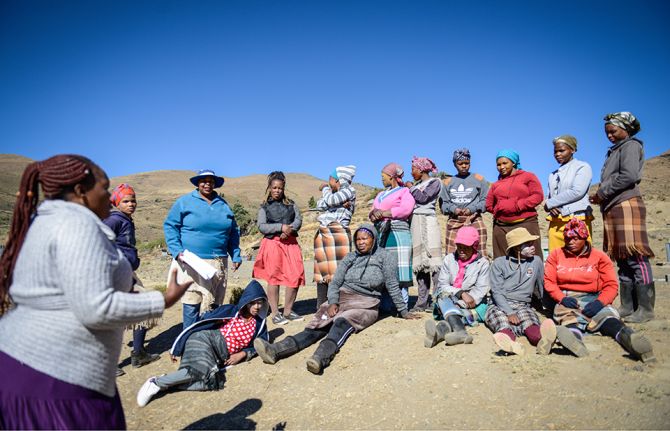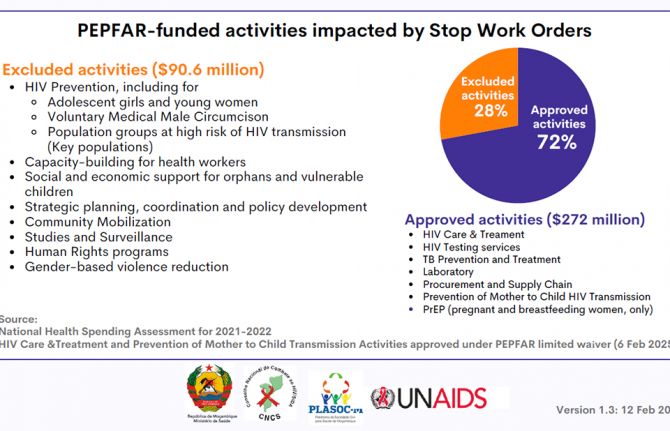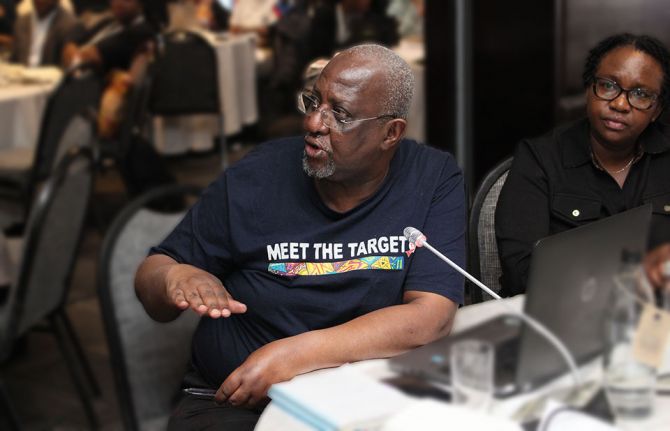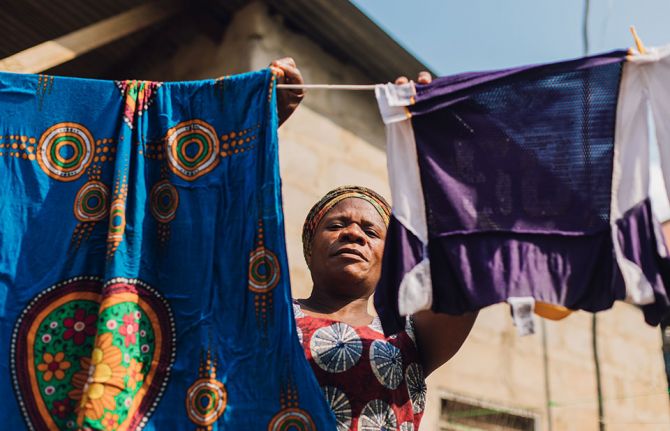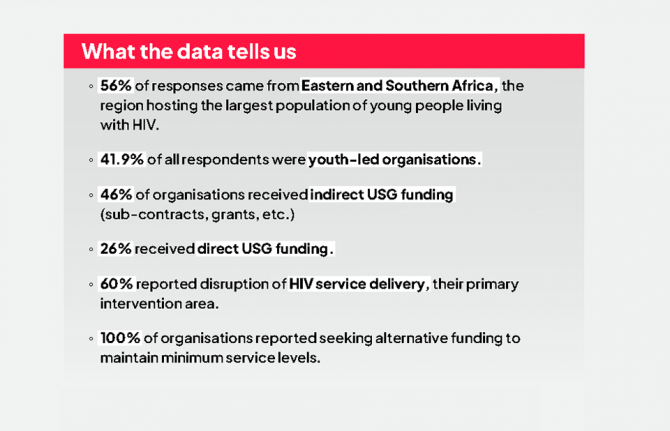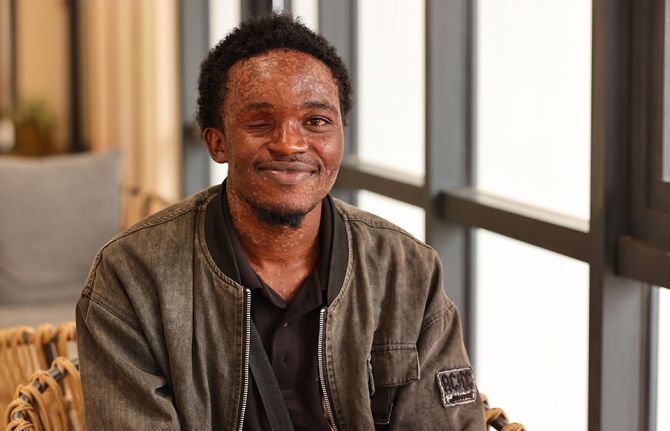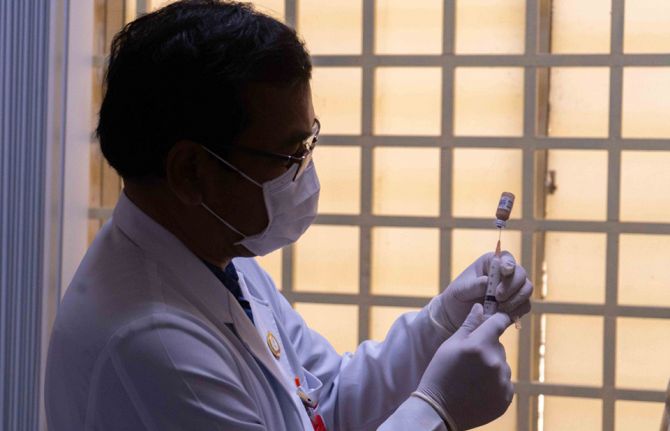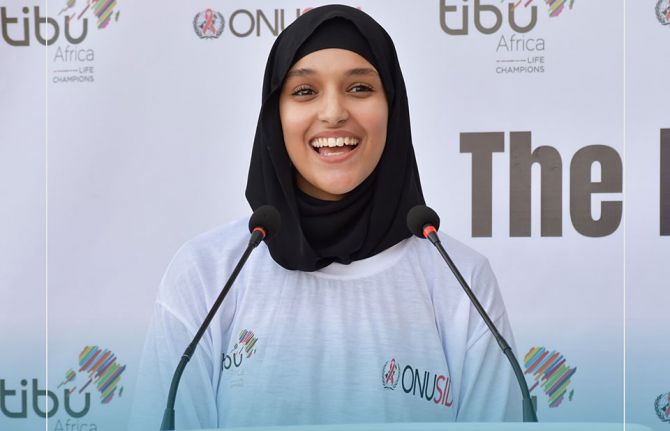
Feature Story
Ahead of PCB, UNAIDS launches handbook on governance
19 June 2009
19 June 2009 19 June 2009
Credit: UNAIDS
Ahead of the 24th meeting of the Programme Coordinating Board (PCB) which opens on 22 June 2009, the Joint United Nations Programme on HIV/AIDS has published the UNAIDS Governance Handbook.
The Handbook is collection of key documents pertaining to the governance of UNAIDS including the founding ECOSOC resolutions, Memoranda of Understanding between the Secretariat and Cosponsoring organizations, and key Political Declarations related to HIV.
The Handbook will prove to be an invaluable reference tool for a wide audience in and around our Board meeting as it gathers together key documents on the governance of UNAIDS in one portable booklet.
Helen Frary, UNAIDS Chief Board and UN Relations.
It is intended as a portable reference tool for a wide audience including member states, Cosponsors, PCB non-governmental organizations as well as UNAIDS staff members.
The Handbook includes descriptions of bodies such as the Committee of Cosponsoring Organizations with guiding principles for UNAIDS Cosponsors. It also details non-governmental civil society participation in Programme Coordinating Board. Under Frequently Asked Questions, it explains the membership and composition of the PCB and its decision making process among other things.
“The Handbook will prove to be an invaluable reference tool for a wide audience in and around our Board meeting as it gathers together key documents on the governance of UNAIDS in one portable booklet,” said Helen Frary, UNAIDS Chief Board and UN Relations.
UNAIDS was established through the Economic and Social Council (ECOSOC) resolution 1994/24 of 26 July 1994 to “undertake a joint and co-sponsored United Nations programme on HIV/AIDS, on the basis of co-ownership, collaborative planning and execution, and an equitable sharing of responsibility” with six UN-system cosponsoring organizations: UNDP, UNICEF, UNFPA, WHO, UNESCO and the World Bank. This group was joined by UNODC in 1999, ILO in 2001, WFP in 2003 and UNHCR in 2003.
The 24th meeting of the PCB will run in Geneva until 24 June.
Publications

Feature Story
Collaboration between TB Alliance and Tibotec offers hope of accelerated tuberculosis drug development
17 June 2009
17 June 2009 17 June 2009
In response to the urgent need to accelerate the discovery and development of new drugs to fight tuberculosis (TB), a landmark collaboration between the Global Alliance for TB Drug Development (TB Alliance), a non-profit, product development partnership, and Tibotec Inc., (Tibotec), a global pharmaceutical company, was announced at the Pacific Health Summit.
The two organizations have agreed to share their expertise and resources in the development of “TMC207”, an anti-tuberculosis drug with a new mechanism of action.
If the encouraging results of early studies are confirmed, TMC207 will represent the first new class of TB drugs we have had in 40 years, offering hope to people living with HIV who are at increased risk of developing TB disease and especially drug-resistant TB.
Dr Alasdair Reid, HIV/TB advisor to UNAIDS
Welcoming the news of the collaboration, Dr Alasdair Reid HIV/TB advisor to UNAIDS said, “If the encouraging results of early studies are confirmed, TMC207 will represent the first new class of TB drugs we have had in 40 years, offering hope to people living with HIV who are at increased risk of developing TB disease and especially drug-resistant TB.”
“The rise of multidrug resistant TB and the lack of new drugs to date are among the biggest threats to TB control and the HIV response,” Dr Reid noted.
The interim data from an ongoing Phase II study of TMC207 were recently published in the New England Journal of Medicine. In the placebo-controlled study of 47 patients with multidrug-resistant TB (MDR-TB), it was found that 48% of patients receiving TMC207 in combination with standard treatment converted to negative sputum culture after eight weeks compared with 9% of those who received placebo and standard treatment.
People living with HIV are susceptible to developing TB and are also particularly vulnerable to MDR-TB which has a higher mortality rate, and is significantly more difficult and costly to treat. In 2008–2009, the highest number yet of MDR-TB cases were reported to WHO, with an estimated half a million new MDR-TB cases emerging annually. Simpler and more effective ways to prevent, diagnose and treat TB in people living with HIV are urgently needed.
The TB Alliance aims to accelerate the discovery and development of new TB drugs that will shorten treatment, be effective against resistant strains, and be compatible with antiretroviral therapies for people living with HIV who have TB.
Integrated HIV and TB services
In Joint Action for Results: UNAIDS Outcome Framework 2009-2011, the UNAIDS Secretariat and Cosponsors recommend effective integrated delivery of services for HIV and tuberculosis in order to prevent people living with HIV from dying of tuberculosis.
UNAIDS Executive Director Michel Sidibé is committed to mobilizing leadership in confronting the interlinked epidemics of TB and HIV and to bring the AIDS and TB movements closer together. Earlier this year while participating at the 3rd Stop TB Partners Forum, Mr Sidibé met with TB Programme Managers and TB civil society and stressed that the epidemics of TB and HIV can no longer be addressed in isolation. “We need to ensure that people living with HIV do not die of TB,” Mr Sidibé said.
TB is among the leading causes of death among people living with HIV, and accounts for an estimated 23% of AIDS deaths worldwide.
Collaboration between TB Alliance and Tibotec off
Cosponsors:
Partners:
Feature stories:
Call for global action on the threat of drug-resistant tuberculosis (03 April 2009)
Need for scale up in integrated TB and HIV screening to address linked epidemics (24 March 2009)
ICASA 2008: Collaborative TB and HIV activities essential (03 december 2008)
MDR-TB more common in people living with HIV (28 February 2008)
External links:
Global Alliance for TB Drug Development (TB Alliance)
Tibotec
Pacific Health Summit
Publications:
Global Tuberculosis Control 2009
Joint Action for Results: UNAIDS Outcome Framework 2009–2011 (pdf, 388 kb.)
Related

Feature Story
General Assembly review on HIV/AIDS
16 June 2009
16 June 2009 16 June 2009As the HIV response represents one of the soundest of all possible global investments, it is critical that commitment to HIV efforts be maintained and strengthened in the midst of these economic challenges - Report of the Secretary-General to the 63rd General Assembly.

Dr Aaron Motsoaledi, Minister of Health of South Africa addressed the General Assembly on 16 June 2009
Credit: UN Photo/Jenny Rockett
At the 63rd session of the General Assembly held in New York on 16 June 2009, the United Nations Secretary-General Ban Ki-moon presented a report on the progress made in the implementation of the Declaration of Commitment on HIV/AIDS and the Political Declaration on HIV/AIDS. The first address by UN member states was delivered by Dr Aaron Motsoaledi, the new Minister of Health of South Africa. Speaking on behalf of the Southern African Development Community (SADC), Motsoaledi noted recent progress made in South Africa and in the SADC region in confronting AIDS.
This year’s report provides an update on developments in the AIDS response, looks forward to the agreed 2010 milestones, recommends key actions to accelerate progress and urges renewed commitment to the goal of universal access to HIV prevention, treatment, care and support.
In June 2008, the General Assembly held a High-level Meeting on HIV/AIDS that assessed progress in the response to the global HIV epidemic. Reports from 147 countries showed that important progress had been made, including in the areas of access to antiretroviral therapy and the prevention of mother-to-child transmission.
However, the report shows that, despite such encouraging developments, considerable challenges remain, including significant access gaps for key HIV-related services. The pace of new infections continues to outstrip the expansion of treatment programmes, and commitment to HIV prevention remains inadequate. While funds available for HIV in low- and middle-income countries increased from $11.3 billion in 2007 to $13.7 billion in 2008, there has been a global economic downturn since the 2008 High-level Meeting.
As the HIV response represents one of the soundest of all possible global investments, it is critical that commitment to HIV efforts be maintained and strengthened in the midst of these economic challenges, report of the Secretary-General.
The Secretary-General’s report also highlights that despite the many commitments made by Member States to protect the rights of people living with HIV and people vulnerable to HIV infection, many countries have laws and policies that are inconsistent with the commitments and result in reduced access to essential HIV services and commodities.
In 2007, one third of countries reported that they still lacked laws to prohibit HIV-related discrimination, and many countries with anti-discrimination legislation have problems with adequate enforcement. A total of 84 countries reported that they have laws and regulations that present obstacles to effective HIV prevention, treatment, care and support for vulnerable subpopulations. Furthermore, some 60 countries have laws that restrict the entry, stay and residence of people living with HIV based on HIV-positive status only. Finally, an increasing number of countries have enacted overly broad laws that criminalize transmission or exposure to HIV, as well as non-disclosure of HIV status. Such measures are likely to lead people to avoid HIV testing, thereby undermining efforts to achieve universal access. Therefore, the report recommends that laws and law enforcement should be improved and programmes to support access to justice should be taken to scale to prevent discrimination against people living with HIV. HIV-related travel restrictions should be eliminated; the criminalization of HIV transmission should be limited to intentional transmission; and laws that burden or impede service access among sex workers, men who have sex with men and injecting drug users should be repealed.
Improved analytic methods have enabled countries to better characterize the magnitude and dynamics of their epidemics, to select appropriate interventions and tailor evidence-informed strategies to address their specific national context. The strategic tailoring of national responses magnifies the results of HIV programmes and reduces waste and inefficiency. Improved monitoring and evaluation systems also permit countries to revise national strategies as their epidemics evolve over time. In their efforts to closely align national strategies with actual national circumstances, countries should work to understand and address the social and structural determinants of HIV risk and vulnerability, such as gender inequalities, social marginalization and stigma and discrimination.
The HIV epidemic presents a long-term global challenge and requires a sustained commitment for an effective long-term response. As the coverage and quality of HIV programmes increase, the report calls to intensify efforts to strengthen the health, education, social welfare and other key sectors, and to integrate HIV with tuberculosis, sexual and reproductive health and other health services.
The long-term AIDS response will be sustainable only if substantially greater success is achieved in slowing the rate of new HIV infections, while providing optimal services for people living with HIV, the report underlines. Bringing to scale the appropriate mix of behavioural, biomedical and structural HIV-prevention strategies would more than halve the number of all new HIV infections between now and 2015. Access to such a combination of prevention strategies, however, remains sharply limited in most countries according to the Secretary-General’s report.
Finally, the report emphasizes that achieving national universal access targets by 2010 will require an estimated annual outlay of $25 billion within two years, necessitating renewed commitment from all providers of HIV-related funding. Sustaining an effective AIDS response will require unprecedented leadership at all levels, including from Governments, civil society and affected communities.
General Assembly review on HIV/AIDS
Feature stories:
UN General Assembly meets on AIDS (22 May 2007)
Multimedia:
View video of UN Secretary-General and UNAIDS Executive Director addressing the media on the occasion of the General Assembly Plenary Meeting on HIV/AIDS.
View photo gallery
External links:
Publications:
Related

Feature Story
Top UN officials urge continued AIDS funding amid economic crisis
16 June 2009
16 June 2009 16 June 2009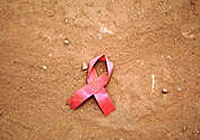
Credit: UNAIDS
Top United Nations officials today urged countries to maintain and strengthen their commitments to tackle HIV and AIDS in the midst of the global economic downturn, warning that slashing resources now could mean greater costs and suffering in the future.
Addressing a meeting of the General Assembly convened to assess progress in the response to the global epidemic, its President, Miguel D’Escoto, noted that people living with HIV/AIDS have been placed at greater risk as a result of the global financial and economic crisis that is crippling economies around the world.
“As a result of this ongoing crisis, I fear that many governments are resigned to reducing programmes and diminished expectations,” he told delegates. “But it is precisely when times are difficult that our true values and the sincerity of our commitment are most clearly evident.
Achieving universal access to prevention, treatment, care and support is a human rights imperative. It is essential that the global response to the AIDS epidemic is grounded in human rights and that discrimination and punitive laws against those most affected by HIV are removed.
Michel Sidibé, Executive Director, UNAIDS
“Even as we see signs of cutbacks in AIDS funding in many countries, we must remind governments and the international community that the world has the resources to mount the kind of AIDS response to which we have committed.
“If we allow cuts now, we will face increased costs and great human suffering in the future,” he stated.
In 2006, the Assembly pledged to achieve universal access to comprehensive HIV prevention, treatment, care and support by 2010. A report by Secretary-General Ban Ki-moon on progress on HIV/AIDS commitments shows that achieving national universal access targets by 2010 will require an estimated annual outlay of $25 billion within two years.
Mr. D’Escoto said that, as the Joint UN Programme on HIV/AIDS (UNAIDS) has pointed out, the amounts needed to achieve this goal represent “a miniscule fraction” of the sums that have been spent this year on economic stimulus measures.
The Secretary-General’s report also highlights a number of encouraging developments such as countries establishing clear national targets for universal access, and a continued increase in financing for HIV programmes in low- and middle-income countries, reaching $13.7 billion in 2008.
At the same time, the report says considerable challenges remain, including significant access gaps for key HIV-related services. Also, the pace of new infections continues to outstrip the expansion of treatment programmes, and commitment to HIV prevention remains inadequate.
“Now is not the time to falter,” Secretary-General Ban Ki-moon told the meeting. “The economic crisis should not be an excuse to abandon commitments – it should be an impetus to make the right investments that will yield benefits for generations to come.”
Mr. Ban said that a vigorous and effective response to the AIDS epidemic is integrally linked to meeting global commitments to reduce poverty, prevent hunger, lower childhood mortality, and protect the health and well being of women.
“But to achieve the goal of universal access, barriers to progress need to be overcome. Not just in battling the disease, but also in confronting obstacles that society puts in the way,” he said, adding that the fight against AIDS also requires attacking “diseases of the human spirit – prejudice, discrimination, stigma.”
He called on all governments to review their legal frameworks to ensure compliance with the human rights principles on which a sound AIDS response is based. “This is not solely a medical or scientific challenge. It is a moral challenge, too,” he said.
Speaking to reporters after addressing the meeting, the Secretary-General discussed his own efforts to attack prejudice, discrimination and stigma. Among them, he said he met regularly with UN staff who lived with HIV and that he is pushing for all people living with HIV to participate in society without fear of discrimination.
He was joined by UNAIDS chief Michel Sidibé, who commended Mr. Ban’s leadership in helping to break the “conspiracy of silence” on stigma, discrimination and criminalization against people living with HIV, particularly among vulnerable groups – homosexuals, sex workers and drug users.
He added that “time is running out,” noting that the 2010 deadline for achieving universal access is right around the corner. “Unfortunately, we are far from reaching our goals.”
Some 84 countries have reported that they have laws and policies that act as obstacles to effective HIV prevention, treatment, care and support for vulnerable populations, according to UNAIDS.
“Achieving universal access to prevention, treatment, care and support is a human rights imperative. It is essential that the global response to the AIDS epidemic is grounded in human rights and that discrimination and punitive laws against those most affected by HIV are removed,” stated Mr. Sidibé.
Top UN officials urge continued AIDS funding amid
Feature stories:
General Assembly review on HIV/AIDS (16 June 2009)
Multimedia:
External links:
United Nations (UN)
Publications:

Feature Story
Economic crisis challenges UN health Goals
16 June 2009
16 June 2009 16 June 2009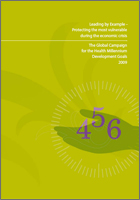
The 2009 report of the Global Campaign of the Health MDGs: Leading by Example - Protecting the most vulnerable during the economic crisis.
The United Nations Secretary-General Ban Ki-moon and the Foreign Minister of Norway Jonas Gahr Støre launched the 2009 report of the Global Campaign of the Health MDGs, Leading by Example - Protecting the most vulnerable during the economic crisis. The launch coincided with the High-Level Forum on Advancing Global Health in the Face of Crisis which was held on 15 June at United Nations Headquarters, New York.
The report highlights that recent actions from governments, international agencies and civil society have started to show positive impact on the health of mothers and children. This has given hope for accelerating progress towards the Millennium Development Goals (MDGs) 4 & 5 —aiming to reduce child mortality by two-thirds and maternal mortality by three-quarters by 2015. However, this progress is now threatened by the most severe global economic crisis since the 1930s, especially in low-income countries.
According to the report, more money is needed to accelerate the progress towards the health goals and more specifically to save millions of mothers and their newborn babies.
The Network of Global Leaders, which includes twelve leaders from developing and donor countries, contributed to the report and they urged leaders to take measure to protect the vulnerable, especially women and children, from the economic downturn. "The global economic crisis demonstrates how inter-dependent we have become as a global community. This is the time to honour our commitments and invest in our common future," say the leaders in their signed overview of the report.
The Global Campaign for the Health MDGs was launched by Prime Minister Stoltenberg with other global leaders in New York in September 2007. The aim of the campaign is to increase and sustain the political and financial commitment for the health MDGs, in particular those protecting the most vulnerable, women and children.
The Network of Global Leaders is a group of international leaders that provide political backing and advocacy at the highest possible level for the Global Campaign for the Health MDGs.
Economic crisis challenges UN health Goals
Feature stories:
AIDS and Global Health (15 June 2009)
Publications:
Leading by Example - Protecting the most vulnerable during the economic crisis
Related

Feature Story
New publication champions a strategic approach to HIV and education
15 June 2009
15 June 2009 15 June 2009
According to A Strategic Approach: HIV & AIDS and Education, this sector can play a central part in the response to HIV by “doing more of what it is doing already and doing it better.”
Credit: UNESCO
Education can play a critical role in the global challenge to HIV simply by “doing more of what it is doing already and doing it better,” and ensuring that all children have access to good quality learning. This is a key conclusion emerging from a new publication by the UNAIDS Inter-Agency Task Team (IATT) on Education which explores what is already known and what needs to be learned about expanding the education sector’s response to the epidemic.
A Strategic Approach: HIV & AIDS and Education is being launched this week at the IATT Symposium taking place in Limerick, Ireland, by Peter Power T.D., Minister of State for Overseas Development. It examines how education can help mitigate the effects of HIV and how this key sector should be an integral part of any national AIDS programme. The report, an extensive update on a previous 2003 publication, highlights the fact that education in itself provides protection against the virus and that more and better schooling should therefore be the first line of the response. A second and complementary measure is the introduction of specific actions tailored to the epidemic, such as the provision of HIV and sexuality education.

Credit: UNESCO
Michel Sidibé, UNAIDS Executive Director, states in the publication’s foreword that “Education is empowering. It facilitates the acquisition and use of knowledge, competencies, attitudes and behaviours that are essential for healthy lifestyles….it enhances public accountability, promotes inter-generational dialogue and leads to better use of available services, especially health and social protection.” He adds: “education can address the social, cultural and economic conditions that contribute to increased vulnerability...”
Aimed at decision-makers and practitioners in the field of education and their partners working on the AIDS response in other sectors, A Strategic Approach: HIV & AIDS and Education identifies key priorities.
Education is empowering. It facilitates the acquisition and use of knowledge, competencies, attitudes and behaviours that are essential for healthy lifestyles….it enhances public accountability, promotes inter-generational dialogue and leads to better use of available services, especially health and social protection.
Michel Sidibé, UNAIDS Executive Director
There is an emphasis on ‘knowing your epidemic’ so that each response is tailor-made to fit the local epidemiological reality. It also argues for two central objectives: first, the prevention of HIV (including the reduction of both social vulnerability and individual risk-taking) and, second, the mitigation of the impact of AIDS.
The report also contends that young people should be given access to the full range of information and resources so that they can protect themselves effectively. This requires that curriculum and learning materials be available in clear and understandable language and that HIV and sexuality education be delivered in an age-appropriate and culturally sensitive manner. Education should “comprehensively cover” such issues as relationships, sexual networks (including same-sex relations) and drug use. However, the publication also points to a recent study among young people in Africa by the Guttmacher Institute which shows that although most teenagers think sex education should be taught in schools, less than half of them receive it.

Credit: UNESCO
A Strategic Approach: HIV & AIDS and Education is primarily focused on school-based learning but it recognises that many of the young people most at risk have often never been to school or have dropped out. This demonstrates the importance not only of reaching out-of-school young people but of enlarging the provision of education, making sure more girls attend school and that greater numbers of children make the transition from primary to secondary institutions.
Empowering young people to protect themselves from HIV is one of the eight priority focus areas for UNAIDS and its Cosponsors under the Joint action for results: UNAIDS outcome framework 2009-2011. Through A Strategic Approach: HIV & AIDS and Education, the UNAIDS Inter-Agency Task Team hopes that this central aim can be brought a step closer to being realised.
Formed in 2002, the IATT on Education is convened by UNESCO and brings together UNAIDS Cosponsors, bilateral agencies, private donors and civil society partners with the purpose of accelerating and improving a coordinated and harmonised education sector response to HIV.
Copies of A Strategic Approach: HIV & AIDS and Education can be requested free of charge from info-iatt@unesco.org Please specify quantity, language version(s), and mailing address. If you are requesting more than 5 copies, please state intended use.
New publication champions a strategic approach to
Cosponsors:
Feature stories:
UNAIDS Task Team develops effective tools to help young people tackle HIV (05 June 2009)
Global online forum to give teachers a voice on HIV (14 may 2009)
HIV response and the education sector: UNESCO Best practice series (04 May 2009)
Supporting young learners living with HIV in Namibia and Tanzania (23 December 2008)
ICASA 2008: Courage and hope, African teachers living positively (03 December 2008)
Publications:
A Strategic Approach: HIV & AIDS and Education ( En | Fr | Es ) (pdf, 2.44 Mb. | 2.31 Mb. | 2.27 Mb.)
Toolkit for Mainstreaming HIV and AIDS in the Education Sector: Guidelines for Development Cooperation Agencies. (UNAIDS IATT on Education, 2008) ( En | Fr | Es ) (pdf, 1.01 Mb. | 904 Kb. | 1.02 Mb.)
Advocacy Briefing Notes – Girls’ Education and HIV Prevention. (UNAIDS IATT on Education, 2008) (pdf 252 Kb.)
Advocacy Briefing Notes – HIV and AIDS Education in Emergencies. (UNAIDS IATT on Education, 2008) (pdf, 275.6 Kb.)
Advocacy Briefing Notes – Mainstreaming HIV in Education. (UNAIDS IATT on Education, 2008) (pdf, 277.1 Kb.)
Advocacy Briefing Notes – Teachers Living with HIV and AIDS. (UNAIDS IATT on Education, 2008) (pdf, 273 Kb.)
UNESCO: Good Policy and Practice in HIV & AIDS and Education Series
Booklet 1: Overview
(pdf, 2.62 Mb.)
Booklet 2: HIV & AIDS and Safe, Secure and Supportive Learning Environments
(pdf, 5.06 Mb.)
Booklet 3: HIV & AIDS and Educator Development, Conduct and Support
(pdf, 1.06 Mb.)
Booklet 4: Partnerships in Practice (pdf, 5.11 Mb.)
Booklet 5: Effective Learning (pdf 3.70 Mb.)
Related
 “Who will protect our young people?”
“Who will protect our young people?”

02 June 2025

Feature Story
HIV prevention central to the AIDS response
15 June 2009
15 June 2009 15 June 2009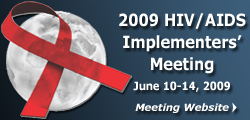
This year’s Implementers Meeting was marked by a sense that the global response to AIDS has moved into a new phase – a time when it is necessary to take thoughtful stock of what has been achieved over the last few years.
The 2009 HIV/AIDS Implementers’ Meeting opened on June 10 in Namibia, drawing more than 1,500 participants from more than 55 countries around the world to Windhoek. With the theme : “Optimizing the Response: Partnerships for Sustainability”, this year’s meeting focused on optimizing the impact of prevention, treatment and care programmes, enhancing programme quality, promoting coordination among partners and encouraging innovative responses to the AIDS pandemic.
“This meeting represents a renewed call to all partners to continue working together to fight the AIDS pandemic,” said H.E. Hifikepunye Phamba, President of the Republic of Namibia who opened the meeting. “It serves as another important platform to showcase the successes that have been achieved over the years. This in turn should motivate everyone to persevere in the noble work that is being done.”
In his opening speech, UNAIDS Deputy Executive Director, a.i., Paul De Lay spoke about the global pledge to move towards universal access to HIV prevention, treatment, care and support and stressed that although a number of countries have taken great strides to reach universal access for antiretroviral treatment and prevention of mother to child transmission, there are many that are struggling to bring services to those who need them. He urged countries to continue spending on AIDS during the current economic downturn: “the life-saving programmes you are putting in place will yield dividends that last for generations,” he said.
The opening ceremony was preceded by a meeting between UNAIDS and United States Government representatives. The meeting discussed the U.S. President's Emergency Plan for AIDS Relief (PEPFAR) Partnership Frameworks between partner governments and other partners that will guide PEPFAR’s response to AIDS in the host countries through service delivery, policy reform, and coordinated financial commitments. The meeting was also a chance for UNAIDS and the US Government to establish a mechanism for regular communication in the future. UNAIDS expressed appreciation toward the US Government’s effort to encourage coordination and synergies at country level and increasing the efficient use of resources.
Kate Thomson, UNAIDS Chief of Civil Society Partnerships spoke about the UNAIDS’ commitment to promoting gender rights and equality and to remove punitive laws, policies and practices as well as the stigma and discrimination that hinder effective responses to HIV. In response, PEPFAR reaffirmed its endorsement of a rights-based approach and its commitment to creating more enabling environments.
At a press briefing moderated by UNAIDS with the participation of key representatives from the Implementers Meeting co-sponsors, journalists and reporters where introduced to universal access to treatment, care and support and were briefed on some of the key strategies and frameworks governing current AIDS work.
During the briefing, key issues surrounding HIV prevention were presented by Helen Jackson, Senior HIV Prevention Advisor with the UNAIDS Regional Support Team for Eastern and Southern Africa. She stressed the importance of prioritising evidence-based interventions and the need to focus on combination prevention, that is, combining a series of behavioural, structural, and biomedical prevention approaches to achieve maximum impact on HIV prevention.
On June 11, one of the sessions moderated by UNAIDS focused on stigma and discrimination and presented a new tool to measure and understand HIV-related stigma called the, ‘People Living with HIV Stigma Index’. The Index is one of a number of tools developed over the last decade to measure and better understand HIV-related stigma. Kate Thomson, UNAIDS Chief of Civil Society Partnerships said that this tool is particularly important because “it can shape future programmatic interventions and policy change.” “The Index will be a powerful advocacy tool which will support governments, civil society and activists alike to reduce the stigma and discrimination linked to HIV,” she added.
On the same day, Susan Kasedde, Regional Advisor with the UNAIDS Regional Support Team for Eastern and Southern Africa moderated a satellite session with the title ‘Knowledge Translation and HIV Incidence Measurement’. During this session, countries reported on the results of the “Modes of HIV Transmission” studies they carried out last year with the support of UNAIDS and the World Bank.
“It was particularly interesting to hear from the country representatives on how the results of the Modes of Transmission studies have impacted on policy and strategy development at the national level and on the overall national discourse around HIV prevention,” said Kasedde.
In Kenya, the studies’ results have helped defined the country’s national HIV prevention strategy while in Lesotho, they have prompted the development of a national behaviour change communication strategy. Uganda has defined a new prevention policy and guidelines and has declared 2010 the ‘year of couple testing’ based on findings from the study that most infections occur in long term, stable relationships which were previously perceived to be low risk.
This year’s Implementers Meeting was marked by a sense that the global response to AIDS has moved into a new phase – a time when it is necessary to take thoughtful stock of what has been achieved over the last few years. The global economic downturn has heightened the need for reflection about what works – and what does not work – and to increase efficiency of programme implementations in all areas of the response to AIDS.
HIV prevention central to the AIDS response
Partners:
U.S. President’s Emergency Plan for AIDS Relief (PEPFAR)
The Global Fund to Fight AIDS, Tuberculosis and Malaria
UNAIDS
UNICEF
World Bank
World Health Organization
Global Network of People Living with HIV/AIDS
Press centre:
Read Press release: 2009 HIV/AIDS Implementers’ Meeting Opens in Namibia
Read Press Release: Namibian President to Open 2009 HIV/AIDS Implementers’ Meeting
Speeches:
Read speech by UNAIDS Deputy Executive Director Programme, a.i. at the opening of the 2009 HIV/AIDS Implementers Meeting (10 June 2009)
Feature stories:
Grass roots projects supporting people living with HIV (12 June 2009)
2009 HIV/AIDS Implementers' Meeting (10 June 2009)
HIV implementers gather in Kampala to share ideas, experiences in AIDS response (03 June 2008)
External links:
2009 HIV/AIDS Implementers’ Meeting official web site
Read live blog on the 2009 HIV/AIDS Implementers’ Meeting by former reporter for the Boston Globe John Donnelly
Related

Feature Story
AIDS and global health
15 June 2009
15 June 2009 15 June 2009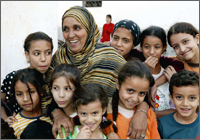
A short report by UNAIDS on AIDS and Global Health examines the role that the health sector should play in helping to attain the goal of universal access to HIV prevention, treatment, care and support. Credit: UNAIDS/P.Virot
The High-Level Forum on Advancing Global Health in the Face of Crisis is taking place at United Nations Headquarters on Monday, 15 June 2009. The Secretary-General is hosting the day long forum in order to elevate the global health debate and engage multisectoral representatives from around the world.
A short report by UNAIDS on AIDS and Global Health made available for this event examines the role that the health sector should play in helping to attain the goal of universal access to HIV prevention, treatment, care and support. Over the past decade the AIDS response has played a major role in producing better health outcomes for people in developing countries and has mobilized a whole range of stakeholders in efforts to build health systems worldwide. However, much work still needs to be done.
The AIDS epidemic is part of the global health landscape, just as the global health agenda is part of the AIDS response. The new report shows that the response to AIDS is an opportunity to improve health systems worldwide. Also discussed is that other areas that contribute to health solutions, such as human rights, the law and education, need to be embraced if we are to maximize outcomes, and that health equity must be addressed.
Shortfall in health resources
Investment in global health has increased significantly in recent years, and investment in the AIDS response has grown from US$ 300 million in 1996 to nearly US$ 14 billion in 2007. However, resources are still falling short for all health needs, and AIDS is no exception. With 7400 new HIV infections each day, the shortfall grows ever greater, and to achieve universal access in 2010 will require US$ 25 billion: US$ 11 billion more than is available today. Advocates for global health must therefore find ways to increase sound investments in health and the AIDS response.
Community services strengthened
It has been shown that there are many beneficial effects from an increase in AIDS resources being spent on health and community systems. A case study described in the report looks at how increased funding for HIV in Nigeria has trickled down to improvements at the local level in a whole range of areas, which in turn helps in the fight against many other diseases. Focusing on a hospital in Jengre, Nigeria, the case study shows that AIDS funding has helped provide free services for children and pregnant mothers enrolled in antenatal care, in addition to enabling major improvements in the hospital’s infrastructure and its ability to tackle the other poverty diseases: tuberculosis and malaria.
Linking AIDS treatment and HIV prevention to other health issues, such as sexual reproductive health, tuberculosis and safe motherhood, has meant that they themselves receive more attention. AIDS responses have also strengthened hospital infection control and improved blood safety and transfusions. The issue of paediatric AIDS has contributed to the debate on better medicines for children, and new opportunities have emerged to challenge those social norms that contribute to ill health.
HIV: health issue and social issue
AIDS and global health notes that HIV is both a health issue and a social issue. By involving the education, agriculture, business, media, labour and other social service sectors, the AIDS response has been able to leverage better health outcomes, just as efforts to eradicate polio and reduce tobacco use have done in recent years. HIV has highlighted the underlying causes of poor health: social determinants such as gender inequality, stigma, migration and lack of education. A lesson learned is that social determinants must be addressed when addressing global health needs.
Sections of the report on tuberculosis and HIV, climate change and HIV and A (H1N1) influenza stress the diverse areas that global health and AIDS cut across.
In conclusion, the report reminds us that much has been accomplished under the emergency conditions of the past 25 years, but that the global response is at a crossroads. The AIDS response and the health response should not work in isolation, but should be united around one common goal: results for people.
AIDS and global health
Feature stories:
Economic crisis challenges UN health Goals (16 June 2009))
Multimedia:
Publications:
AIDS and global health (pdf, 450 Kb)

Feature Story
Cartoons to help stop tuberculosis
12 June 2009
12 June 2009 12 June 2009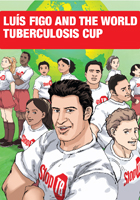
The comic book Luis Figo and the World Tuberculosis Cup seeks to teach children and teens about tuberculosis, its relationship with HIV, and how to prevent it.
International football icon and Stop TB Ambassador Luis Figo is the main character of an educational comic book that provides key information on tuberculosis (TB). Luis Figo and the World Tuberculosis Cup was produced by the Stop TB Partnership, an international health partnership whose secretariat is housed by the World Health Organization (WHO) in Geneva, with support from UNAIDS.
The comic book features Figo as the captain of a team of teen-aged girls and boys. Together they win a football match against a squad of tuberculosis germs. The comic book seeks to teach children and teens about tuberculosis, its relationship with HIV, and how to prevent it.
Tuberculosis is a killer, and I want all of you to stay safe from it. I am passing the ball to you -- you can help reach the goal of stopping tuberculosis.
International football icon and Stop TB Ambassador Luis Figo
In a statement released on the occasion of the launch Figo urged young people everywhere to take the comic book's messages seriously. "Tuberculosis is a killer, and I want all of you to stay safe from it. I am passing the ball to you -- you can help reach the goal of stopping tuberculosis," he said.
The book is available in Arabic, Chinese, English, French, Khmer, Kiswaili, Hindi, Portuguese, Russian, and Spanish and is being distributed in several countries in collaboration with local partners. An estimated number of 70 000 comic books have been so far distributed through country-based events. The comic book is also available for download at www.stoptb.org/figo
An international competition for comic artists to design the educational book was launched in 2008. A jury of cartoon experts from worldwide organizations together with representatives from UN organizations selected the winning proposal which was presented in Lisbon on 24 July 2008.

HIV and TB are so closely connected that they are often referred to as co-epidemics or dual epidemics.
The comic book has now become an animated cartoon that will be launched in Geneva on 13 June during the All Stars '09, a charity match organized by the Luis Figo Foundation. The animated cartoon version of Luìs Figo and the World Tuberculosis Cup will be shown in its French-language version at the gala match. It will soon also be available in Arabic, English, Portuguese, Russian and Spanish and broadcast widely around the world.
The fundraising game will take place at the Stade de Genève and will also feature current and former soccer stars and trainers including Mourinho, Chistian Chivu, Ronaldinho, Clarence Seedorf, Fabio Capello, Giovanni Trapattoni and Giga Popescu.
Tuberculosis and HIV
TB is the leading causes of death among people living with HIV, and accounts for an estimated 23% of AIDS deaths worldwide. HIV and TB are so closely connected that they are often referred to as co-epidemics or dual epidemics. The epidemics drive and reinforce one another: HIV activates dormant TB in a person, who then becomes infectious and able to spread the TB bacillus to others.
Untreated, someone with active tuberculosis will infect an estimated 10 to 15 people per year. The Stop TB Strategy is the internationally recommended standard for preventing, diagnosing and treating TB and includes recommendations for managing TB in people living with HIV.
Recently a new TB strain, extensively drug resistant TB (XDR TB), has emerged, which is particularly dangerous for people living with HIV in whom it is frequently fatal. Preventing the development and spread of drug resistant TB through greater investment in TB services, improved community case finding and adherence support, and more effective infection control are essential.
UNAIDS, the Stop TB Partnership and the World Health Organization (WHO) are together encouraging a concerted, coordinated global effort to control TB in people living with HIV. In addition, the Stop TB Partnership has formed the TB/HIV Working Group, which develops global policy on the control of HIV-related TB and advises on how those fighting against TB and HIV can work together.
These partnerships have led to the creation of policies and guidelines to deal with HIV-related TB, and countries and organizations have taken important steps towards integrating their HIV and TB responses.
Cartoons to help stop tuberculosis
Cosponsors:
Partners:
Multimedia:
Luis Figo and the World Tuberculosis Cup (animated version) (fr)
Collaboration between TB and HIV services helps save lives (24 March 2009)
Feature stories:
Need for scale up in integrated TB and HIV screening to address linked epidemics (24 March 2009)
ICASA 2008: Collaborative TB and HIV activities essential (03 December 2008)
Publications:
Luis Figo and the World Tuberculosis Cup (pdf, 45,29 Mb)
Related

Feature Story
Grass roots projects supporting people living with HIV
12 June 2009
12 June 2009 12 June 2009As part of the 2009 HIV/AIDS Implementers meeting being held in Windhoek, Namibia, delegates had the opportunity to visit HIV projects in the area to find out what is being done on the ground to support people living with HIV.
One of the projects was the Bernhard Nordkamp Social Service Centre which offers training and outreach programmes for HIV prevention, care and support, voluntary HIV testing and counselling, post-test support groups and an after school learning programme.
Since it was established by Catholic AIDS Action in 1999, the centre which is Namibia’s first faith-based community HIV outreach and support centre, has registered over 1,500 orphans and vulnerable children. The children receive choir practice, music classes, art therapy, and homework assistance. A computer lab, which helps the children improve their mathematics and English skills through computer aided learning, is also available for use.
“It is impressive to see the dedication of the staff and volunteers,” said Paul De Lay, UNAIDS Executive Director Programme, ad interim. “It is the commitment of organisations like this which is really making a difference to peoples lives at the community level.”
The centre also runs a soup kitchen catering for 130 children each day, primarily children most in need including children living with HIV and orphans.
Some 60 volunteers work for the centre and provide support to nearly 600 families through their home-based family care services. This programme also reaches around 990 orphans who receive psychosocial support. Another of the centre’s activities is to provide income generating projects for people living with HIV. One of the activities, called the “Beaded Red Ribbon” project, is providing income to around 25 families. Other income generating activities include producing greeting cards, jewellery, and Christmas ornaments.
Grass roots projects supporting people living wit
Partners:
U.S. President’s Emergency Plan for AIDS Relief (PEPFAR)
The Global Fund to Fight AIDS, Tuberculosis and Malaria
UNAIDS
UNICEF
World Bank
World Health Organization
Global Network of People Living with HIV/AIDS
Press centre:
Read Press Release: Namibian President to Open 2009 HIV/AIDS Implementers’ Meeting
Read Press release: 2009 HIV/AIDS Implementers’ Meeting Opens in Namibia
Speeches:
Read speech by UNAIDS Deputy Executive Director Programme, a.i. at the opening of the 2009 HIV/AIDS Implementers Meeting (10 June 2009)
Feature stories:
2009 HIV/AIDS Implementers' Meeting (10 June 2009)
HIV implementers gather in Kampala to share ideas, experiences in AIDS response (03 June 2008)
External links:
2009 HIV/AIDS Implementers’ Meeting official web site
Read live blog on the 2009 HIV/AIDS Implementers’ Meeting by former reporter for the Boston Globe John Donnelly

